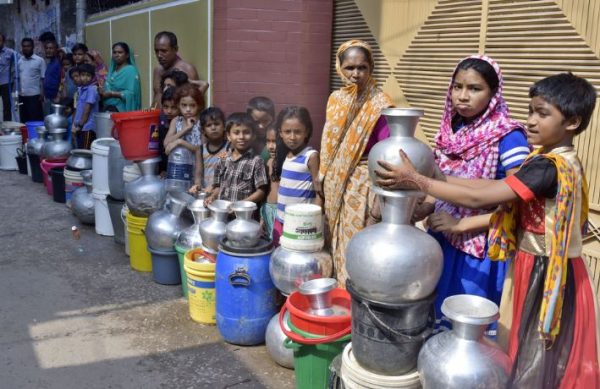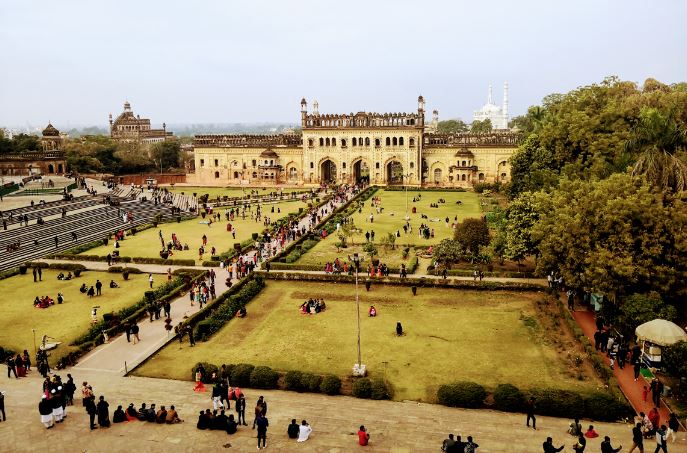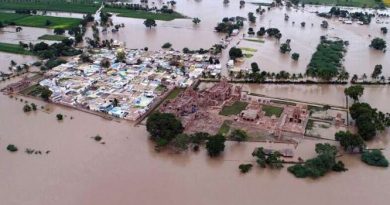Missing Water. The River disputes that matter to Indians
 A twist for every turn
A twist for every turn
While we can reminisce the famous line from The Rime of the ancient mariner by Samuel Taylor Coleridge- “Water Water everywhere, Nor a drop to drink” the symbolism has become uncanny for the present.
Water disputes are the bone of contention, a line of fire, and borders or even wars which have been dividing nations figuratively and literally for thousands of years. Famous examples are the Nile basin conflict between Egypt and Ethiopia or public discontent in Yemen over water shortage. There are tensions from 1960s among Turkey, Syria and Iraq, with Iran who share the Euphrates-Tigris Basin, or a transboundary dispute between Afghanistan and Iran.
Closer home, we have our worries with China over the Brahmaputra river, Teesta river with Bangladesh and last but not the least with Pakistan Over Indus water sharing treaty. Lets have a closer look:
India’s Worries over China interference with Brahmaputra flows
Despite the size and importance of the massive interconnected river system China and India share (along with Nepal, Bhutan and Bangladesh), no integrated structure exists for its management, and the bilateral agreements that govern it are far from sufficient. That’s possibly because when China annexed Tibet (where the key rivers affecting India originate), in 1950, it left very little scope for talks.
The mighty Brahmaputra River, known in China as the Yarlung Tsangpo, flows through both countries on its way to the Bay of Bengal. That waterway links up with the Meghna and Ganges rivers in Bangladesh, forming a system that carries the largest volume of water during the flood season — a volume more than one and a half times that of the Amazon River. But as a 2016 report by the United Nations Environment Program and its partners found, The Ganges-Brahmaputra-Meghna Basin is also the world’s most vulnerable delta, based on more than a dozen key indicators. Part of the problem is that China, which borders 14 countries and shares over 42 major water bodies, has refused to be a part of any institutionalized water management system.
Teesta Water Issues with Bangladesh
Teesta is a 414km long river flowing through the Indian states of West Bengal, Sikkim before going to the Bay of Bengal through Bangladesh. It is the fourth largest transboundary river shared between India and Bangladesh after Ganges, Brahmaputra, and Meghna river systems. Total catchment area: 1.75 million Sq. km. The dispute is regarding water sharing of River Teesta. Bangladesh wants a higher share than it gets now. Currently, its share is lower than that of India’s.
Indus Water Treaty with Pakistan
The Indus is one of Asia’s mightiest rivers, it flows through the Indian state of Jammu & Kashmir and along the length of Pakistan to the Arabian Sea. The river and its five tributaries together make up the Indus Basin, which spans four countries and supports 215m people.
India and Pakistan also share an important aquifer – essentially a vast pool of underground water covering an area of 16.2m hectares across both countries. This “groundwater” helps support the huge population in the Indus region, accounting for 48% of all water withdrawals in the basin.
Climate change is also affecting monsoon patterns in South Asia, and could result in less rainfall for India and Pakistan. This could be disastrous as summer monsoon rainfall provides 90% of India’s total water supply. Moreover, the basin’s watershed area has suffered tremendous environmental degradation and massive deforestation on both sides of Kashmir, leading to a decrease in the annual water yield. India has been ‘letting go’ of its share of Indus waters, but now wants to stop the practice. A tough task, given the high cost of creating infrastructure to do so.
Well if you thought these were all the water fights India was fighting, you are clearly mistaken. There are 8 more disputes which continue to meander along like a river themselves, occasionally flooding in to public consciousness, but mostly, staying in the background.
Dispute over water in the Cauvery Basin in India
The long-standing conflict over water from the Cauvery River between the Indian states Karnataka and Tamil Nadu has recently resurfaced in the context of drier climate conditions. The implications are not only legal battles, but also violent protests following decisions to alter water distribution between the two states.
Vamsadhara Dispute
Vamsadhara is an inter-state river that originates from Thuamul Rampur of Kalahandi district in Odisha, flows through about 265 km – 154 km through Odisha, 82 km through Andhra Pradesh and 29 km through the AP-Odisha border. Andhra and Odisha had signed an agreement to share the reassessed yield of Vamsadhara at GottaSet featured image, which is about 105 tmcft. Each agreed to utilise about 52.5 tmcft. For utilisation of its share, the Andhra Pradesh Government had started constructing a barrage against which, the Odisha Government moved the Supreme Court in 1962, alleging that the proposed barrage would lead to inundation of low-lying villages of Gajapati and Rayagada districts. The dispute still lingers with no final solution yet.
Ravi And Beas water fights between Haryana and Punjab
Ravi & Beas Waters Tribunal was constituted in 1986 for verification of the quantum of usage of water claimed by Punjab, Haryana and Rajasthan regarding their shares in remaining waters. The Tribunal forwarded a report in January, 1987. The States of Punjab, Haryana and Rajasthan and Central Government made references to the tribunal seeking clarification/ guidance on certain points of the report under the provisions of the Inter-State River Water Disputes (ISRWD) Act, 1956. The matter is subjudice before Tribunal.
Mahadayi river dispute
The dispute over Mahadayi river began in the 80s and grew stronger in the subsequent decades. The trigger was Karnataka’s move to design a number of dams, canals and barrages to route the Mahadayi river water to the Malaprabha basin. The state claimed that channelling the river water into the basin of Malaprabha, a tributary of the Krishna, would meet the requirements of water-scarce districts of Bagalkot, Gadag, Dharwad and Belagavi. Goa contends that its population is dependent on the river’s natural path and any move to divert it would affect its fragile ecosystem. It claimed that the ingress of saltwater in the river, which is dependent on monsoons, will ultimately end up killing the state’s mangroves and green belt, disturb the relationship between the people and the land, as well as the ecological balance.
Krishna Water Disputes Tribunal (KWDT)
Krishna Water Disputes Tribunal (KWDT) is a tribunal set up by the Central Government in 1969 under the Interstate River Water Disputes Act, 1956 to resolve the disputes between the states of Karnataka, Maharashtra and then undivided Andhra Pradesh over sharing of Krishna river water. After reorganisation of Andhra Pradesh, a case was filed by AP and Telangana to redistribute water among all 4 states. The KWDT-II pronounced its judgement on the litigation filed by Andhra Pradesh and Telangana. Both states in their petition had sought fresh allocation of Krishna River water among all four riparian states. The verdict states that river water should be re-allocated between Telangana and Andhra Pradesh, from the share of undivided Andhra Pradesh.
Indirasagar Polavaram
Indirasagar Polavaram, an interstate project on river Godavari has been conceived as a part of recommendations of Godavari Water Disputes Tribunal (GWDT). The project implements Godavari-Krishna link under Interlinking of rivers project. Indira Sagar (Polavaram) project is located on river Godavari and is multipurpose major terminal reservoir project on river Godavari for development of Irrigation, Hydropower and drinking water facilities to East Godavari, Vishakhapatnam, West Godavari and Krishna districts of Andhra Pradesh by diverting 80 TMC waters to river Krishna. Odisha has raised the issue of submergence of a number of villages in their state due to the construction of Polavaram project. The project is under construction in West and East Godavari Districts of Andhra Pradesh and its reservoir spreads to parts of Chhattisgarh and Odisha. The project will submerge about 600 villages in Andhra Pradesh, Chhattisgarh, Odisha and Telangana and also about 8,000 acres of forest and 500 acres of the wild life sanctuary. The environment clearance of the project was cancelled by the National Environment Appellate Authority in 2007 but the Andhra Pradesh High Court had stayed it as an interim measure. The Ministry of Environment and Forest had given a direction to stop the construction work of the project on 8 February, 2011, but had later kept its own order in abeyance.
The Babhali project
The Babhali project / barrage is a controversial reservoir project being constructed by Maharashtra across the river Godavari, disputed by Telangana. The Supreme Court delivered a ruling after seven years in favour of Maharashtra with the Andhra Pradesh government expected to appeal against it.
Mullaperiyar Dam
The Mullaperiyar dam on Periyar river is a source of dispute between the governments of Kerala and Tamil Nadu. The tension between the two states over the issue has persisted since the 1960s, with Kerala citing concerns regarding the dam’s safety and arguing for the reduction of the dam’s water levels. But with the water from the dam being diverted to five districts in Tamil Nadu and its importance in the state’s irrigation and power production practices, the state has consistently opposed this.
Although the dam is located in Kerala, it is operated by Tamil Nadu following an 1886 lease indenture for 999 years that was signed between the Maharaja of Travancore and the Secretary of State for India for the Periyar Irrigation works. Constructed between 1887 and 1895, the dam redirected the river to flow towards the Bay of Bengal, instead of the Arabian Sea and provide water to the arid rain region of Madurai in Madras Presidency.
picture credit: Wikimedia Commons








